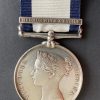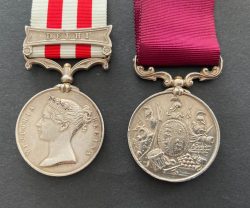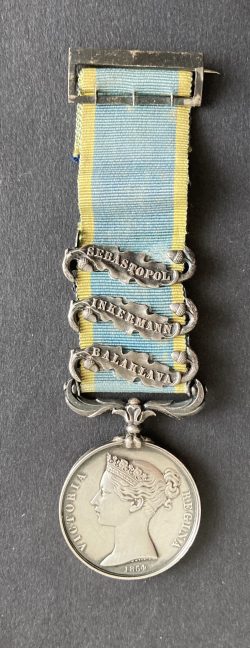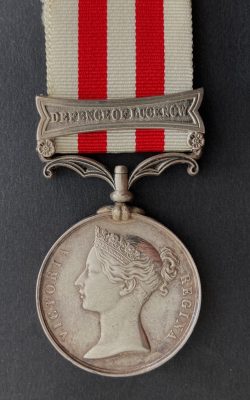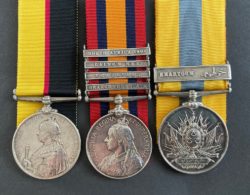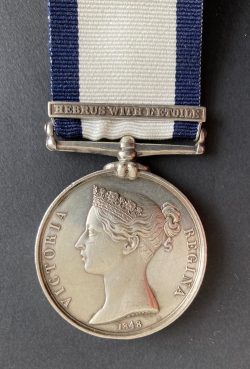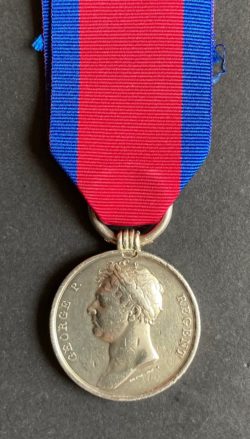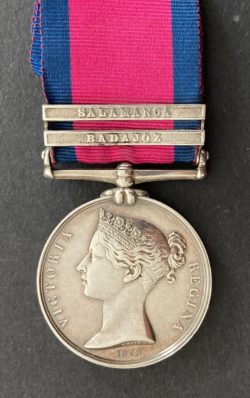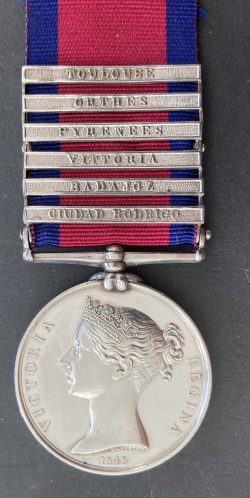A superb of 2nd World War, Lieutenant/Trooper North Irish Horse. Military Cross (GVI). Military Medal (GVI). MC for 9/10 Apr. 1945 as first troop across the Senio River and holding the bridgehead, MM whilst in a forward position under fire target marking resulting in the destruction of 2 x Mark V1 tanks and the disablement of several others. Wounded in the winter of 1944/45 by shrapnel left embedded in later life. Rejected a battlefield commission not wishing to change regiments was in due course commissioned into his own unit. Later called to the Bar and as the leading criminal advocate on the northern circuit, his most famous case being lead prosecutor of the 12 defendants in the infamous ‘Handless Corpse’ drug trafficking and murder trial, then the longest and most expensive in British legal history.
£15,750.00
Out of stock
Military Cross (GVI) reverse dated 1945, Military Medal (GV1- Tpr. N. Ir. H) , 1939/45 Star, Africa Star, clasp, 1st Army, Italy Star, War Medal.
Lieut. A.M. Maguire, North Irish Horse
Military Cross L.G. date 13th December 1945, Lt (MM) North Irish Horse.
Recommendation : –
‘On 9/10 Apr. at the SENIO river, Lieut. Maguire’s was the first troop of tanks across the river and his bold action ensuring the holding of the bridgehead. The next day April 10th troops led the break-out; by skilled manoeuvre he drove off four enemies S. Ps and assisted the infantry in the capturing of many prisoners. On the night of the 12 April he played a conspicuous part in a 6,000 yards night advance and on the following morning his troop – unaccompanied by infantry went right along the banks of SANTERNO shooting up many posts. He reached the RENO- SENTO junction thus clearing the way for the GRUPPO CREMONA. This officer has shown consistent dash and eagerness to engage the enemy. Throughout winter he took part in four very successful troop actions and was wounded whilst carrying out a dismounted patrol. He inspired his troop with the greatest confidence and fighting spirit and has carried out the most difficult and dangerous tasks with unfailing success.’
Military Medal L.G. 22nd April 1943, Trooper North Irish Horse.
M.M. L.G. 22/4/1943
Recommendation
‘On 1st March Trooper Maguire and Corporal Cox were sent out to report enemy movements in the area 3248 and 3348(TUNISIA, sheet 4) They took their carrier as far as was judged safe and then went forward on foot to an O.P. Enemy tanks were seen and a report was sent back by wireless from the carrier to H.R.Q. Artillery fire was brought to bear and Trooper Maguire and Corporal Cox returned again to their O.P where they corrected the fire at intervals for a period of approximately 2 hours. As a result, two Mk VI’s were destroyed, and several others already disabled were heavily damaged. To send in their reports, they took it in turns to traverse the 300 yards back to the carrier under considerable M.G. and small arms fire. Their O.P. was frequently under heavy mortar fire and their conduct throughout was exemplary and inspiring.’
His obituary from The Telegraph 28th December 2001 states:
‘MICHAEL MAGUIRE, who has died aged 78, won a Military Medal in 1943 and a Military Cross in 1945 while serving with the North Irish Horse; he later became a formidable jury advocate on the Northern circuit.
Albert Michael Maguire was born on December 30 1922 at Preston, Lancashire, where his father, of Northern Irish ancestry, ran a property company.
Brought up in the village of Bay Horse, Lancashire, Michael went to Hutton Grammar School, where he excelled at cricket and rugby. On leaving he volunteered for the Royal Armoured Corps.
After training at Warminster, he joined the North Irish Horse as a trooper in Tunisia. Six weeks later, on March 1 1943, he was sent out to report enemy movements in the area of Sedjanene in the central highlands of the country.
He and Corporal Cox took their vehicle as far as they judged safe and then went forward on foot to an observation point. After seeing enemy tanks, they sent a report back by wireless to RHQ.
When artillery fire was brought to bear on the tanks, Maguire and Cox went back to their observation point, where they spent two hours correcting the aim of the guns on the targets. In order to send back their reports, the two men took it in turns to brave heavy mortar fire while traversing the 300 yards back to their vehicle.
As a result of their directions, two enemy Mk VIs were destroyed and several others badly damaged. Maguire was awarded the Military Medal for his “exemplary and inspiring” conduct throughout the operation.
After receiving his award in Carthage, Maguire refused a commission in the field – since to do so would have meant switching regiments – and instead went to Sandhurst. After being commissioned, he rejoined his old regiment – by no means a usual procedure – for the advance up Italy, where he again demonstrated outstanding bravery.
On the night of April 9/10 1945, during Operation Buckland (the 8th Army’s final push in north-eastern Italy), Maguire – by then a lieutenant – led the first troop of tanks to cross the river Senio, after which his bold action ensured the holding of the bridgehead.
The next day, April 10, his troop led the break-out. By skilful manoeuvre, he drove off four enemy self-propelled guns and assisted the infantry in the capturing of many prisoners.
On the night of April 12, Maguire played a conspicuous part in a 6,000 yd night advance, and the following morning his troop, unaccompanied by infantry, went right along the banks of the river Santerno, shooting up enemy posts. He got as far as the junction between the Senio and Reno rivers, thus clearing the way for the following Italian force.
The citation for Maguire’s MC recorded: “This officer has shown consistent dash and eagerness to engage the enemy. Throughout the winter he took part in four very successful troop actions and was wounded while carrying out a dismounted patrol. He inspired his troop with the greatest confidence and fighting spirit, and has carried out the most difficult and dangerous tasks with unfailing success.”
When the North Irish Horse was disbanded, Maguire joined the Inns of Court Regiment, and worked for the War Crimes Investigation Unit.
After demobilisation in 1946, he went up to Trinity Hall, Cambridge, to read Law. On graduating he read for the Bar and was called by Middle Temple as a Harmsworth Scholar in 1949. Having served his pupillage in the Temple, he moved to chambers in Liverpool to practise on the Northern circuit.
There, heedless of the shrapnel still lodged in his body from his war wounds, he began once more to play rugby, turning out for Preston Grasshoppers.
As a junior barrister, Maguire worked predominantly in the civil field, specialising in employers’ liability cases. For example, he acted for Dunlop’s insurers in a complicated case involving employees who had contracted bladder cancer.
But after taking Silk in 1967 he rapidly established himself as the leading criminal advocate on the Northern circuit. His advocacy was fearless and to the point – there was never any flannel or pomp.
In 1970 and 1971 he served as the last Recorder of Carlisle, but after the Beeching reforms abolished the post, he stoutly declined all invitations to become a new-style recorder. He preferred to remain an advocate in the North, rather than return to London.
Among his many high profile cases, he prosecuted the 12 defendants in the “Handless Corpse” trial at Lancaster Castle in 1981. The case, then the longest (at six months) and most expensive trial in British legal history, concerned a New Zealand drug trafficker, Marty Johnson, whose headless and handless corpse was discovered in a flooded quarry at Heskin, near Chorley.
Johnson had been murdered by associates in the drug world after it was discovered that he had been selling below-par cocaine. His killers then did what they could to make it impossible to identify Johnson. But in their eagerness and haste to hack off their victim’s head and hands, and to dump his partially dismembered corpse in the reservoir, they omitted to remove his medallion.
The body came to rest on a shallow ledge, and was discovered the next weekend by divers on scuba practice. When a picture of the medallion was published in a newspaper, Johnson’s girlfriend contacted the police.
During the trial, which resulted in nine convictions, Maguire was at his incisive best. At one stage, counsel for the defendants asked for the case to be transferred to the Old Bailey on the ground that the cells at Lancaster Castle were inhumanely cold.
The judge, Dame Rose Heilbron, turned to the prosecution counsel: “Well, Mr Maguire, what do you say?” “None of them,” said Maguire, “are so cold as Mr Johnson”.
In another case, after Maguire had destroyed a police officer in cross-examination, he asked the man how long he expected to remain in the Force. “I expect to reach superintendent,” the officer replied. “Don’t bank on it,” returned Maguire.
As Leader of the Northern circuit from 1980 until 1984, Maguire took great pains to look after the interests of his fellow barristers, especially younger members of the circuit. His speeches at Bar dinners were elegant and witty, and he was the master of the one-liner.
An open, generous character, Mick Maguire was very popular with his fellow barristers. Sartorially, some thought he looked like Al Capone, with his vicuna overcoat, crocodile-skin shoes, and rakishly angled hat.
Away from the Bar, he liked to spend time in the country, whether on his sheep farm in Scotland, or at his house in France.
He is survived by his sister, Dr Anne Maguire, with whom he lived for many years.’
Thought to be some 45 combinations of MC/MM during WW2 but we don’t recall the last time we saw one






